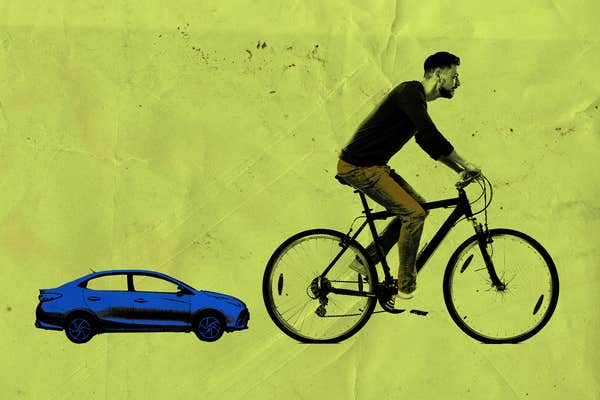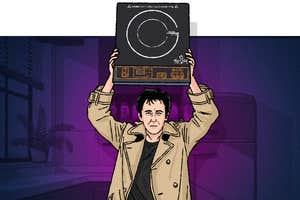
May 22nd, 2025
Hey team, and welcome back to one5c! One stat from today’s main story has been stuck in my head for more than a week: 80% of people in the U.S. say they have “no choice” but to drive. Said another way, four out of every five adult humans in this country feels trapped in their car. That’s a mighty hill to climb, especially when we know that decarbonizing transportation consistently ranks in the top five actions any person can take to cut emissions. So, we asked one of our favorite contributors, Bridget Reed Morawski, to lay out the best tips for chipping away at our time in cars.
—Corinne
THREE EASY WAYS TO DRIVE LESS
By Bridget Reed Morawski

Lorem ipsum dolor sit amet, consectetur adipiscing elit. Mauris in odio leo. If you want to reduce your personal share of carbon emissions, driving less is a surefire way to do it. About 37% of U.S. emissions come from transportation—and an entire 21% of those come from individual drivers’ tailpipes. “Reducing car use can significantly improve quality of life and environmental outcomes,” says Éléonore Pigalle, an urban planner with the Laboratoire Ville Mobilité Transport in Paris. “Fewer cars on the roads means less air pollution, less noise, and less congestion.”
The problem is that Americans are boxed into using cars. Around 80% of drivers feel they have “no choice,” simply because their community doesn’t offer any good alternatives. Close to 92% of households own at least one vehicle, and 21.7% have three or more. While rural areas and suburban towns may be the most obvious candidates for obligatory vehicle usage, plenty of urban communities lack useful public transit options.
Trading a gas-guzzler for an EV will, naturally, take a big bite of anyone’s planet-warming potential, but mile-for-mile nothing quite beats the simple act of driving less. Here are the best options to reduce how much time you spend behind the wheel in places where transit isn’t an option.
Good: Minimize your solo drives
Americans who have cars aren’t just using them for one run a day. In 2023, drivers made an average of 2.43 daily trips, totaling 60.7 minutes and 29.1 miles. A lot of individual runs are remarkably short. The Bureau of Transportation Statistics finds that 52% of all trips—whether by car or by public transit—are within 3 miles of their starting point. So cutting down on the number of times you hop in the car is a good place to shave off some mileage.
This might take a little planning, but there are a few tactics to deploy. You can cluster errands into a single shopping center that’s likely to have everything you need. If that doesn’t work out, sequencing stops can be beneficial, as well: Instead of considering work, a pit stop at the dry cleaner, and dinner with friends completely separate activities, plan how you can complete them in the course of a single journey.
You can also combine errands with your neighbors and nearby friends in a chore-swapping group. Ask them if they want to go in on a Costco run or if someone’s headed to the library and can drop off your books. Getting this going can be as simple as a group chat, a shared spreadsheet, or a Google calendar to coordinate logistics.
Better: Form a car pool
Carpooling cuts down on the total number of vehicles on the road, which can be a huge emissions win. Bumping up average car occupancy (aka driving alone a bit less) can save from 9.06 to 11.07 gigatons of carbon by 2050, according to analysis from Project Drawdown. That’s like erasing almost two years’ worth of all U.S. emissions. Bonus: It’s also less lonely. “Carpooling strengthens connections within existing communities that share similar values and interests,” Pigalle says.
Not sure where to find a ride? The best place to start may be putting a call out to your neighbors on NextDoor, dropping the idea to colleagues, or turning that group chat with your buddies into an open forum for rideshare requests. If Uber is available in your area, using the Uber Pool option can also be handy. There are apps, like BlaBlaCar, that connect riders with drivers headed on the same route, but (alas) it’s not currently available in the U.S.
Best: Bike or walk
There are few things less emitting than moving around with your own two legs. And even the fanciest, most nimble bicycles (and e-bikes) can cost a fraction of most cars. One French study found that cycling instead of driving for just 25% of short car trips could reduce carbon emissions by 257,000 tons, or about 2% of the country’s total transport emissions. Even when you factor in charging, an e-bike still laps cars in terms of greenhouse gas output. Mile by mile, an electric bike creates around 25 grams of carbon, compared with 350 grams in a gas car. Tackling your errands on foot, of course, is the GOAT.
Depending on where you live, though, the switch might be tricky. Not everywhere is suited for a pedestrian lifestyle, so you should check how your area rates on the National Walkability Index. Remember that you may need to plan and pack more carefully for walking and biking journeys. You’ll likely want to tote a reusable water bottle, a hat or sunglasses, a lightweight backpack, and a change of shoes and clothes for when you arrive. (And don’t forget the helmet if you’re on two wheels!)
For trip planning, cyclists might also want to consult a dedicated route planner like Bikemap or Komoot. Classics like Apple Maps and Google Maps are the most reliable for walking journeys. Regardless of which you use, keep the software updated to ensure you’re finding the quickest, safest route.
Product Review
The best portable induction burner
Easy to control and an ace at most cooking tasks, this burner will make you forget about gas. Read the full review.

THE ROUNDUP
IN THE NEWS THIS WEEK
The clean-energy rollbacks in the House’s budget (aka “One Beautiful Bill”) would result in a 6% increase in U.S. emissions through 2035 and 1.4 million lost jobs through 2035, according to an analysis from Greenline Insights. The measure still has to pass through the Senate. If you haven’t yet, call your senators and let them know you want them to protect climate programs and tax incentives.
Oatly has become the first food brand to qualify as a Climate Solutions Company. In its latest sustainability report, the nondairy darling not only laid out plans to cut emissions across its entire product life cycle, but also set goals around making a societal impact beyond its core business. Even if we’re only talking dairy, oat milk has less than one-third the planet-warming potential of cow’s milk.
Climeworks, a company that captures carbon from the atmosphere and sells companies and individuals credits to offset their emissions, isn’t snatching enough of the greenhouse gas to cover even its own footprint, reports the Icelandic outlet Heimildin. “This is the Theranos of the energy industry,” Mark Z. Jacobson, professor of civil and environmental engineering at Stanford University, told the outlet.
Transitioning to EVs and getting microplastic pollution in check are among solutions that could help save struggling bees, says a new report from the University of Reading. “This is not just a conservation issue. Pollinators are central to our food systems, climate resilience and economic security. Protecting pollinators means protecting ourselves,” the study’s lead author told The Guardian.
The Trump administration has lifted its stop-work order on a massive offshore wind farm off of Long Island in New York. Dubbed Empire Wind, the project is the centerpiece of a “just transition” for the Brooklyn neighborhood of Sunset Park, reports The Washington Post. The farm stands to replace fossil fuels in the energy mix while providing thousands of jobs in the community.
Copyright © 2025 one5c. All rights reserved.
Logo design by Claudia De Almeida
Questions? Feedback? Contact the editors at one5c@one5c.com.
Our mailing address is:
3112 Windsor Rd, Ste A-391, Austin, TX 78703
